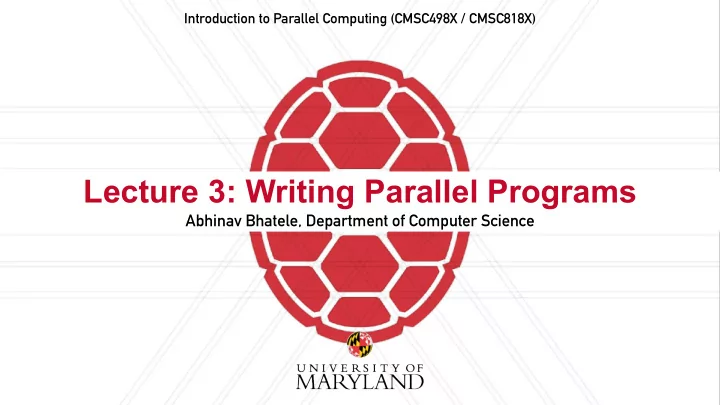

Introduction to Parallel Computing (CMSC498X / CMSC818X) Lecture 3: Writing Parallel Programs Abhinav Bhatele, Department of Computer Science
Announcements • Deepthought2 (dt2) accounts have been mailed to everyone • If you want to use your own account, read the Piazza post and follow instructions Abhinav Bhatele (CMSC498X/CMSC818X) LIVE RECORDING 2
Writing parallel programs • Decide the serial algorithm first • Data: how to distribute data among threads/processes? • Data locality: assignment of data to specific processes to minimize data movement • Computation: how to divide work among threads/processes? • Figure out how often communication will be needed Abhinav Bhatele (CMSC498X/CMSC818X) LIVE RECORDING 3
Two-dimensional stencil computation • Commonly found kernel in computational codes • Heat diffusion, Jacobi method, Gauss-Seidel method A [ i , j ] = A [ i , j ] + A [ i − 1, j ] + A [ i + 1, j ] + A [ i , j − 1] + A [ i , j + 1] 5 Abhinav Bhatele (CMSC498X/CMSC818X) LIVE RECORDING 4
2D stencil iteration in parallel Abhinav Bhatele (CMSC498X/CMSC818X) LIVE RECORDING 5
2D stencil iteration in parallel • 1D decomposition • Divide rows (or columns) among processes Abhinav Bhatele (CMSC498X/CMSC818X) LIVE RECORDING 5
2D stencil iteration in parallel • 1D decomposition • Divide rows (or columns) among processes Abhinav Bhatele (CMSC498X/CMSC818X) LIVE RECORDING 5
2D stencil iteration in parallel • 1D decomposition • Divide rows (or columns) among processes • 2D decomposition • Divide both rows and columns (2d blocks) among processes Abhinav Bhatele (CMSC498X/CMSC818X) LIVE RECORDING 5
2D stencil iteration in parallel • 1D decomposition • Divide rows (or columns) among processes • 2D decomposition • Divide both rows and columns (2d blocks) among processes Abhinav Bhatele (CMSC498X/CMSC818X) LIVE RECORDING 5
N-body problem https://developer.nvidia.com/gpugems/gpugems3/part-v-physics-simulation/chapter-31-fast-n-body-simulation-cuda Abhinav Bhatele (CMSC498X/CMSC818X) LIVE RECORDING 6
N-body problem • Simulating the movement of N-bodies under gravitational forces https://developer.nvidia.com/gpugems/gpugems3/part-v-physics-simulation/chapter-31-fast-n-body-simulation-cuda Abhinav Bhatele (CMSC498X/CMSC818X) LIVE RECORDING 6
N-body problem • Simulating the movement of N-bodies under gravitational forces • Naive algorithm: O(n 2 ) • Every body calculates forces pair-wise with every other body (particle) https://developer.nvidia.com/gpugems/gpugems3/part-v-physics-simulation/chapter-31-fast-n-body-simulation-cuda Abhinav Bhatele (CMSC498X/CMSC818X) LIVE RECORDING 6
Data distribution in N-body problems • Naive approach: Assign n/k particles to each process • Other approaches? http://datagenetics.com/blog/march22013/ https://en.wikipedia.org/wiki/Z-order_curve Abhinav Bhatele (CMSC498X/CMSC818X) LIVE RECORDING 7
Data distribution in N-body problems • Naive approach: Assign n/k particles to each process • Other approaches? Space- filling curves http://datagenetics.com/blog/march22013/ https://en.wikipedia.org/wiki/Z-order_curve Abhinav Bhatele (CMSC498X/CMSC818X) LIVE RECORDING 7
Data distribution in N-body problems • Naive approach: Assign n/k particles to each process • Other approaches? Space- filling curves http://datagenetics.com/blog/march22013/ https://en.wikipedia.org/wiki/Z-order_curve Abhinav Bhatele (CMSC498X/CMSC818X) LIVE RECORDING 7
Data distribution in N-body problems • Naive approach: Assign n/k particles to each process • Other approaches? ORB Space- filling curves http://datagenetics.com/blog/march22013/ http://charm.cs.uiuc.edu/workshops/charmWorkshop2011/slides/CharmWorkshop2011_apps_ChaNGa.pdf https://en.wikipedia.org/wiki/Z-order_curve Abhinav Bhatele (CMSC498X/CMSC818X) LIVE RECORDING 7
Data distribution in N-body problems • Let us consider a two-dimensional space with bodies/particles in it Abhinav Bhatele (CMSC498X/CMSC818X) LIVE RECORDING 8
Data distribution in N-body problems • Let us consider a two-dimensional space with bodies/particles in it Abhinav Bhatele (CMSC498X/CMSC818X) LIVE RECORDING 8
Data distribution in N-body problems • Let us consider a two-dimensional space with bodies/particles in it Quad-tree: not all nodes are shown Abhinav Bhatele (CMSC498X/CMSC818X) LIVE RECORDING 8
Load balance and grain size • Load balance: try to balance the amount of work (computation) assigned to different threads/ processes • Bring ratio of maximum to average load as close to 1 as possible • Secondary consideration: also load balance amount of communication • Grain size: ratio of computation-to-communication • Coarse-grained (more computation) vs. fine-grained (more communication) Abhinav Bhatele (CMSC498X/CMSC818X) LIVE RECORDING 9
Abhinav Bhatele 5218 Brendan Iribe Center (IRB) / College Park, MD 20742 phone: 301.405.4507 / e-mail: bhatele@cs.umd.edu
Recommend
More recommend